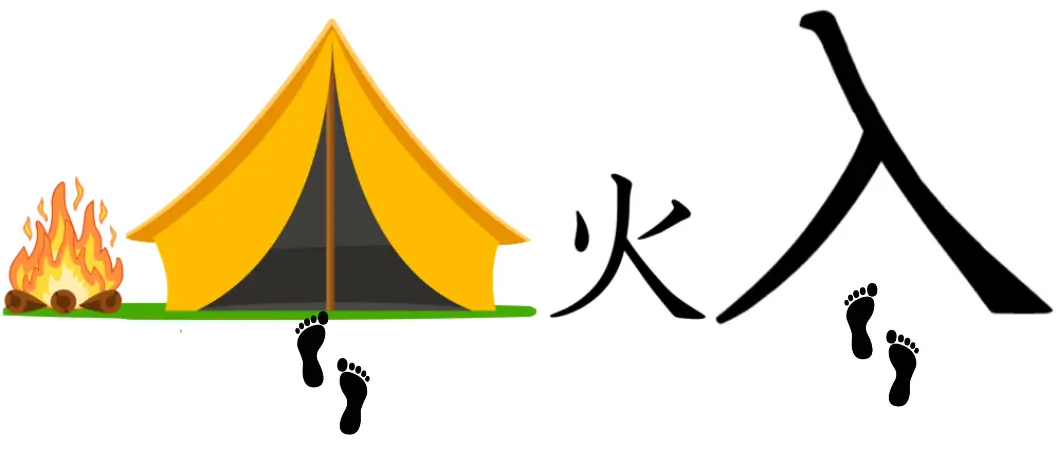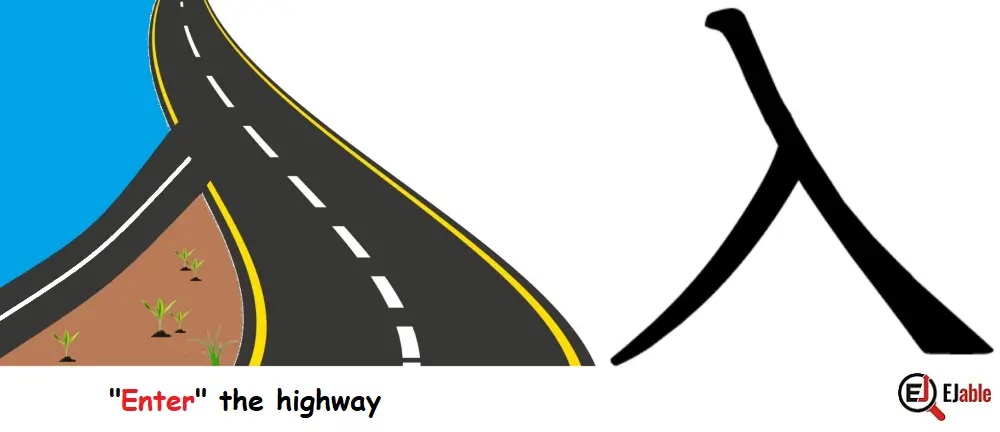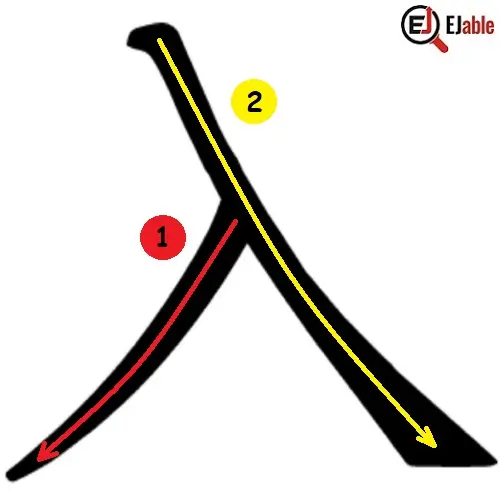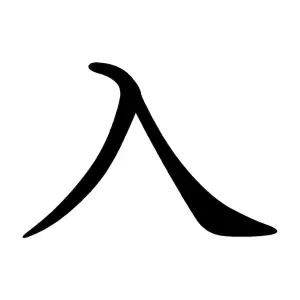Kanji for “Enter”, “Insert”, or “Put in”: 入

The Japanese Kanji 入 means “Enter (to enter),” “Putting in,” and “Insert.”
Various contexts for the usage of 入:
- Enter: It refers to the action of going into a space or location.
- Insert: 入 is also used to describe putting something into something else.
- Admission: 入 is often used in contexts related to being admitted into a group, organization, or institution.
- Include: 入 can signify the inclusion of something as part of a larger whole.
The kun’yomi (Japanese reading) pronunciations of the Kanji 入 are hai-ru (はい-る), or ‘i‘ (い) as in the words “ireru” (い-れる) and “iru” (い-る), and the on’yomi (Chinese reading) pronunciation of 入 is “nyu” (ニュウ).
The Kanji 入 appears in 1284 Japanese names. However, in names, it is pronounced as “iri” (いり), “iru” (いる), “ni” (に), “no” (の), and “riri” (りり).
The Kanji 入 is constructed with 2 strokes. It is part of the JLPT N5 syllabus (please check the list of JLPT N5 Kanji) and is taught in grade 1 in Japanese schools.
Origin of the Shape 入
Just like most other Kanji characters, the shape of the Kanji for “Enter” evolved over time to its current shape 入. However, in all eras, the shape depicted an entrance. This shape of an entrance represents an entry, inserting or putting something inside a space.
The following illustration shows the ancient shapes of the kanji 入 and how we write it today:

The above illustration shows the ancient shape of the kanji 入 in the Oracle Bone Script, Bronze inscription, small seal script, and how we write it today.
Mnemonic to Remember the Kanji 入’s Meaning as “To Enter”
The fact that the shape of the Kanji 入, through its evolution, always depicted an entrance makes it easy to associate with ‘entry‘ and remember it. However, a challenge here is to differentiate it from the Kanji for a person or human being.
The Kanji characters 人 and 入 are those rare characters where it is often hard to differentiate in the shape. Even the stroke orders of these two Kanji are the same. Considering this, the following illustrations can make good pictorial mnemonics to relate the shape 入 to associate it with its meaning as “to enter” or “put into”:
Mnemonic 1

The above illustration shows the entrance of a cave with a similar shape to the inverted “V” shape of 入.
Mnemonic 2

In the above illustration, consider the second longer stroke as a highway, and consider yourself on the smaller road to “enter” that highway.
Stroke Order for the Kanji 入
The following illustrations show the order of the 2 strokes to write the Kanji 入:


入 as a Component in other Kanji Characters
The Kanji 入 is used as a component in 40 Kanji characters, out of which the following 2 are Jōyō (commonly used) Kanji:
- 込 (こむ / komu) – To include, be crowded, and put into.
- Explanation: 込 is a kanji often used to express the action of putting something into something else, or a state where something is crowded or filled. In compound verbs, it typically adds to the meaning of entering or being included, such as in “詰め込む” (tsumekomu, meaning to pack tightly or cram).
- 詮 (せん / sen) – Explanation, elucidation.
- Explanation: This Kanji is used in contexts related to explicating or clarifying something, often implying the analysis or interpretation necessary to understand a concept fully. It reflects the idea of getting to the ‘whole’ or ‘entirety’ of meanings through words. The 入 component suggests bringing ideas “into” discussion or consideration.
入 Kanji in Compounded Words
There are 350 Japanese words that begin with the Kanji for “enter” (入), and it appears in 1057 words overall.
Examples of Kanji 入 in Compounded Japanese Words
- 入学 (にゅうがく / nyūgaku): School entry; refers to admission into an educational institution.
- 入口 (いりぐち / iriguchi): Entrance; the entry point of a building or area.
- 入力 (にゅうりょく / nyūryoku): Input; refers to entering data into a system.
- 入場 (にゅうじょう / nyūjō): Admission; entering into a place such as a theater or a stadium.
- 入社 (にゅうしゃ / nyūsha): Joining a company; the act of starting work at a new company.
- 入院 (にゅういん / nyūin): Hospitalization; entering a hospital for treatment.
- 入手 (にゅうしゅ / nyūshu): Acquisition; getting or obtaining something.
- 入浴 (にゅうよく / nyūyoku): Bathing; entering a bath, especially a large public bath.
- 入金 (にゅうきん / nyūkin): Deposit; putting money into a bank account.
- 入試 (にゅうし / nyūshi): Entrance examination; tests for entry into schools or universities.
- 入門 (にゅうもん / nyūmon): Introduction; a beginner’s guide or entry into a new field of study.
- 入札 (にゅうさつ / nyūsatsu): Bidding; entering a bid for a contract or auction.
- 入れ墨 (いれずみ / irezumi): Tattoo; literally means “inserting ink” into the skin.
- 入居 (にゅうきょ / nyūkyo): Moving in; entering a new residence or apartment.
- 入国 (にゅうこく / nyūkoku): Entry into a country; immigration or customs process.
- 入替 (いれかえ / irekae): Replacement; changing or swapping something by inserting something new.
- 入着 (にゅうちゃく / nyūchaku): Arrival; reaching a destination or entering a port.
- 入党 (にゅうとう / nyūtō): Joining a party; becoming a member of a political party.
- 入魂 (にゅうこん / nyūkon): Pouring one’s soul into something; dedicating effort or passion to a task.
- 入荷 (にゅうか / nyūka): Stock arrival; when goods enter a store or warehouse inventory.
These examples demonstrate how the Kanji 入 is used to convey various concepts related to entering or being included in both literal and abstract senses.
Note: Check other Kanji characters on the page “How to Learn Kanji“ and the guide to Kanji radicals.

A long-term ex-pat in Japan, Himanshu comes with an IT background in SAP consulting, IT Business Development, and then running the country operations of an IT consulting multinational. Himanshu is the co-founder and Managing Director of ReachExt K.K. and EJable.com. He is also an Advisory Board Member of a Silicon Valley AI/IoT startup.
